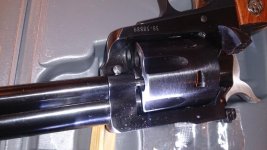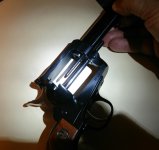"...it hits the edge of the chambers and stops there."
That means, along with a photo he's posted elsewhere clearly showing the rod tip being stopped by the inside (as in the part of the chamber wall closest to the base-pin or center axis) of the chamber wall, that the rod does not travel fully.
It hits, as he said, the chamber edge & stops there.
In that photo it appears the chamber is lined up & centered as correctly as possible.
This is not operator ignorance.
This is not a failure to read the instructions.
This is a man who successfully ran his previous .30 Carbine Blackhawk for several years.
This is a mechanical failure.
Why on earth the instant assumption of operator stupidity?
Denis
That means, along with a photo he's posted elsewhere clearly showing the rod tip being stopped by the inside (as in the part of the chamber wall closest to the base-pin or center axis) of the chamber wall, that the rod does not travel fully.
It hits, as he said, the chamber edge & stops there.
In that photo it appears the chamber is lined up & centered as correctly as possible.
This is not operator ignorance.
This is not a failure to read the instructions.
This is a man who successfully ran his previous .30 Carbine Blackhawk for several years.
This is a mechanical failure.
Why on earth the instant assumption of operator stupidity?
Denis


